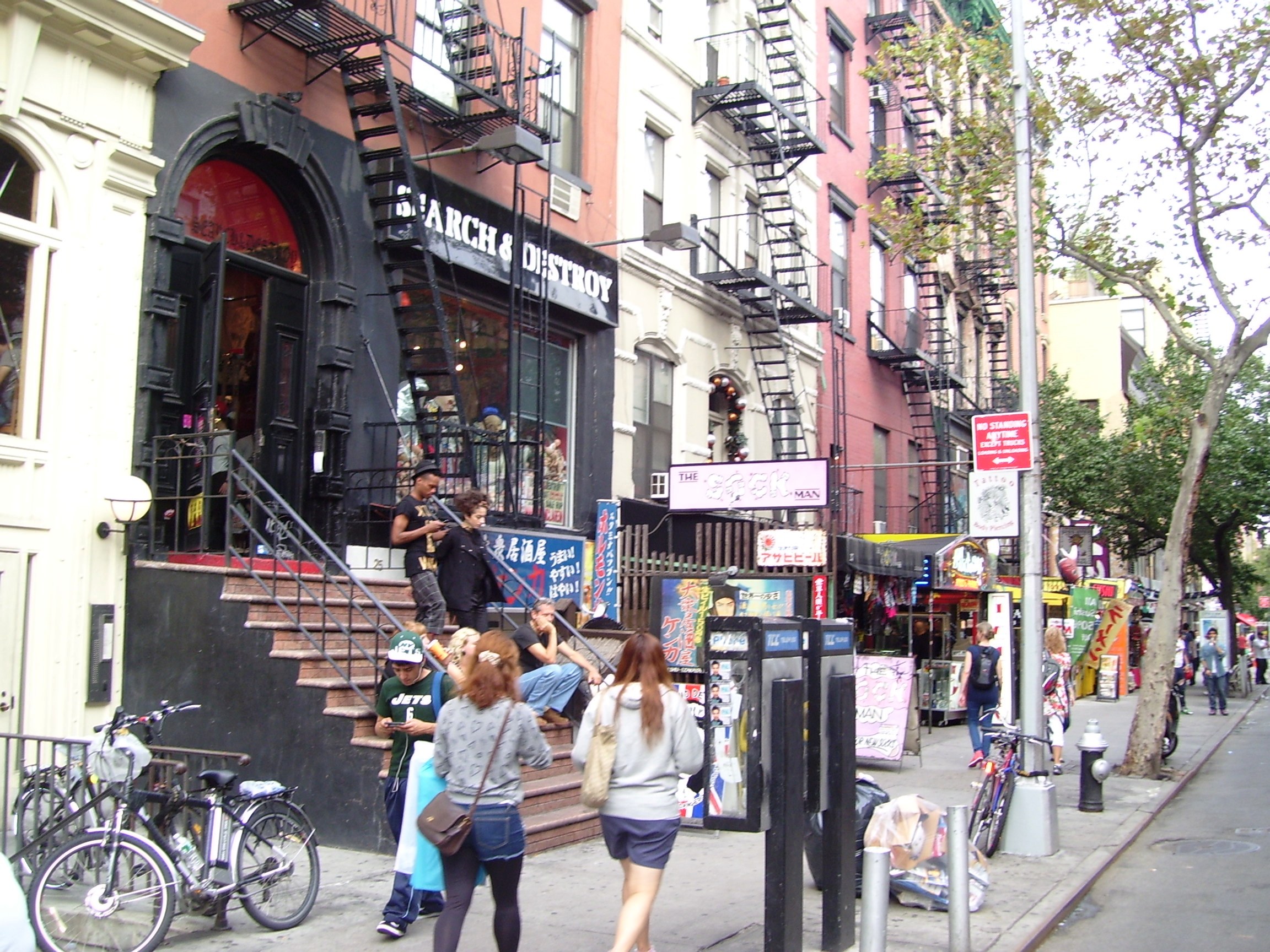
8th Street and St. Mark's Place
8th Street is a street in the New York City borough of Manhattan that runs from Sixth Avenue to Third Avenue, and also from Avenue B to Avenue D; its addresses switch from West to East as it crosses Fifth Avenue. Between Third Avenue and Avenue A, it is named St. Mark's Place, after the nearby St. Mark's Church in-the-Bowery on 10th Street at Second Avenue.
Maintained by
Manhattan, New York City
10003, 10009, 10011
Waverly Place (6th Avenue to Broadway)
7th Street (Bowery to Avenue D)
St. Mark's Place is considered a main cultural street for the East Village. Vehicular traffic runs east along both one-way streets. St. Mark's Place features a wide variety of retailers. Venerable institutions lining St. Mark's Place have included Gem Spa and the St. Mark's Hotel. There are several open-front markets that sell sunglasses, clothing, and jewelry. In her 400-year history of St. Mark's Place (St. Marks Is Dead), Ada Calhoun called the street "like superglue for fragmented identities" and wrote that "the street is not for people who have chosen their lives ... [it] is for the wanderer, the undecided, the lonely, and the promiscuous."[3]
History[edit]
Early years[edit]
Wouter van Twiller, colonial governor of New Amsterdam, once owned a tobacco farm near 8th and MacDougal Streets. Such farms were located around the area until the 1830s.[4] Nearby, a Native American trail crossed the island via the rights-of-way of Greenwich Avenue, Astor Place, and Stuyvesant Street.[4]
The Commissioners' Plan of 1811 defined the street grid for much of Manhattan. According to the plan, 8th Street was to run from Greenwich Lane (now Greenwich Avenue) in the west to First Avenue on the east.[5][6] The area west of Greenwich Lane was already developed as Greenwich Village, while the area east of First Avenue was reserved for a wholesale food market.
The plan was amended many times as the grid took shape and public spaces were added or eliminated. The marketplace proposal was scrapped in 1824, allowing 8th Street to continue eastward to the river.[7] On the west side, Sixth Avenue was extended and Greenwich Lane shortened, shifting the boundary of 8th Street, ever so slightly, to Sixth Avenue and allowing Mercer, Greene, Wooster and MacDougal Streets to continue northward to 8th.[8][9]
19th century[edit]
After the Commissioners' Plan was laid out, property along the street's right of way quickly developed. By 1835, the New York University opened its first building, the Silver Center, along Eighth Street near the Washington Square Park. Row houses were also built on Eighth Street. The street ran between the Jefferson Market, built in 1832 at the west end, and the Tompkins Market, built in 1836, at the east end. These were factors in the street's commercialization in later years.[4]
Eighth Street was supposed to extend to a market place at Avenue C, but since that idea never came to fruition. Capitalizing on the high-class status of Bond, Bleecker, Great Jones, and Lafayette Streets in NoHo, developer Thomas E. Davis developed the east end of the street and renamed it "St. Mark's Place" in 1835.[10] Davis built up St. Mark's Place between Third and Second Avenues between 1831 and 1832. Although the original plan was for Federal homes, only three such houses remained in 2014.[10]
Meanwhile, Eighth Street became home to a literary scene. At Astor Place and Eighth Street, the Astor Opera House was built by wealthy men and opened in 1847.[11] Publisher Evert Augustus Duyckinck founded a private library at his 50 East Eighth Street home. Ann Lynch started a famous literary salon at 116 Waverly Place and relocated to 37 West Eighth Street in 1848.[4] Around this time and up until the 1890s, Eighth Street was co-named Clinton Place in memory of politician DeWitt Clinton, whose widow lived along nearby University Place.[4]
In the 1850s, Eighth Street housed an educational scene as well. The Cooper Union for the Advancement of Science and Art, a then-free institution for art, architecture and engineering education, was opened in 1858. The Century Club, an arts and letters association, relocated to 46 East Eighth Street around that time; the Bible House of the American Bible Society, was nearby. In addition, the Brevoort Hotel, as well as a marble mansion built by John Taylor Johnston, were erected at Fifth Avenue and Eighth Street.[4]
At the same time, German immigrants moved into the area around Tompkins Square Park. The area around St. Mark's Place was nicknamed Kleindeutschland, or "Little Germany", because of a huge influx of German immigrants in the 1840s and 1850s. Many of the homes turned into boarding houses, as the area had 50,000 residents but not a lot of real estate. Tenement housing was also built on St. Mark's Place.[10]
By the 1870s, apartments replaced stables and houses along the stretch of Eighth Street west of MacDougal Street. The elevated Third and Sixth Avenue Lines were also built during that time, with stops along the former at Ninth Street and along the latter at Eighth Street.[4][10]
Notes
Bibliography